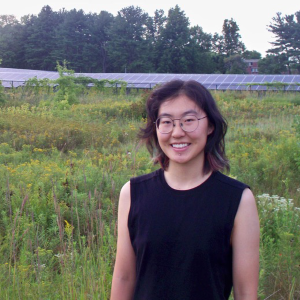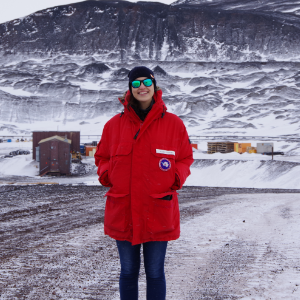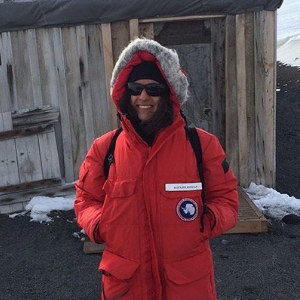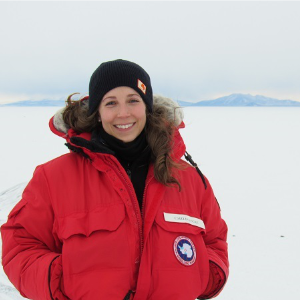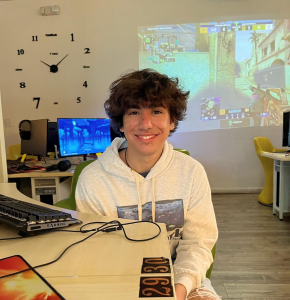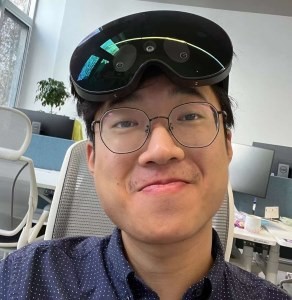Visualizing Ice Sheets in Extended Reality
About
The VISER Project (formerly Pol-AR/VR) is a data visualization endeavor to develop Augmented Reality (AR) and Virtual Reality (VR) applications for polar datasets that simultaneously function as outreach and scientific analysis tools. This is an interdisciplinary project, which involves earth scientists and computer scientists working together to integrate geospatially correct 3-Dimensional datasets in a Extended Reality (XR) environment. This kind of data visualization can lead to elevated data interpretation and analysis.
Neurologically, the more senses one uses to explore a structure, the more efficient the brain is at interpreting it. Our XR applications involve gestures, handset controls, interactive data and menus, voice commands, real-time measurement tools, and more. Allowing the user to manipulate and measure the represented data creates an immersive experience that is difficult to achieve on a desktop computer. 3-D, geospatially correct, dataset integration contextualizes scale, interpretation, and real-world processes. Additionally, XR headsets like the Microsoft HoloLens and Oculus are fairly portable and intuitive to use, which allows our applications to be used for educational outreach, scientific communication, and collaborative explorative analysis.
Our mission with the VISER Project is to continue developing Extended Reality applications for datasets within the Arctic and Antarctic.
VISER Applications
Inside the Ice Shelf: Zoom Antarctica was an Augmented Reality (AR) application developed for the Microsoft HoloLens1. Spearheaded by Martin Pratt and Alexandra Boghosian in 2018, Zoom Antarctica successfully combined LiDAR imagery, ice-penetrating radar imagery, Ross Ice Shelf topographical digital elevation models (DEMs) of the surface and bedrock. These datasets were geospatially correct and aligned with one another, displaying a 3-D rendering of the Ross Ice Shelf in Antarctica.
For more information, click this link: Inside the Ice Shelf Zoom Antarctica
The Greenland Project was a Mixed Reality (XR) application developed for the Microsoft HoloLens1 and Oculus Quest1. Spearheaded by Sofía Sanchez-Zarate, Carmine Elvezio, and Alexandra Boghosian in 2020, The Greenland Project successfully combined ice-penetrating radar imagery, Greenland topographical digital elevation models (DEMs) of the surface and bedrock, in-app measurement tools, cross-platform networking, and more. These datasets were geospatially correct and aligned with one another, displaying a 3-D rendering of the Ryder Ice Shelf in Greenland. The addition of data manipulation and measurement within a cooperative environment was crucial during a global pandemic.
For more information, click this link: The Greenland Project
AntARctica is a Mixed Reality (XR) application developed for the Microsoft HoloLens2 and Oculus Quest2. Spearheaded by the POL-V/AR interdisciplinary development team in 2021, AntARctica successfully combined ice-penetrating radar imagery, surface and bedrock topographical digital elevation models (DEMs), CSV thickness and surface measurements, and more. The application provided: real-time in-app measurement tools, transparency sliders, gesture controls, voice commands, and geographic information. This geospatially correct, 3-D representation of the Ross Ice Shelf and ROSETTA-Ice data allowed earth scientists, and laypeople alike, to explore the Antarctic ice shelf in depth.
For more information, click this link: AntARctica
The Pol-XR application contains two scenes: a Ross Ice Shelf scene developed from the AntARctica application; and a Peterman Ice Shelf scene using MCoRDS radar data. Both scenes combine ice-penetrating radar imagery, surface and bedrock digital elevation models (DEMs), thickness measurements, surface measurements, and more. The application provides: real-time in-app measurements tools, transparency sliders, gesture controls, voice commands, and geographic information. This geospatially correct 3-D representation of polar data, allow earth scientists and interested parties alike, to explore complex polar datasets
For more information, click this link: Pol-XR
Previous Collaborators & Affiliates


Publications:
Visualizing Ice Sheets in Extended Reality (VISER) for the Improvement of Polar Data Analysis
S. Isabel Cordero, Alexandra Boghosian, Joel Salzman, Qazi Ashikin, Eris Gao, Jake Torres, Hao Lucas Yuan, Zihao Zhang, Yolanda Zhu, Carmine Elvezio, Sofía Sánchez-Zárate, Ben Yang, Shengyue Guo, Kirsty Tinto, Steven Feiner, & Robin Bell
AGU 2023 Fall Meeting. Poster IN43B-0624.
Bibcode: (pending)
Augmented Reality and Virtual Reality for Ice-Sheet Data Analysis
Alexandra Boghosian, S. Isabel Cordero, Carmine Elvezio, Sofía Sánchez-Zárate, Ben Yang, Shengyue Guo, Qazi Ashikin, Joel Salzman, Kirsty Tinto,
Steven Feiner, & Robin E. Bell
IGARSS 2023 - 2023 IEEE International Geoscience and Remote Sensing Symposium, Pasadena, CA, USA, 2023, pp. 52-55
doi: 10.1109/IGARSS52108.2023.10283077
AntARctica: An Immersive 3D Look into Antarctica's Ice Using Augmented Reality and Virtual Reality
Alexandra Boghosian, S. Isabel Cordero, Kirsty J. Tinto, Steven Feiner, Robin E. Bell, Benjamin Yang, & Shengyue Guo
AGU 2022 Fall Meeting. Poster IN32B-0394.
Bibcode: 2022AGUFMIN32B0394B
Uncovering the origin of basal features at the Ross Ice Shelf using radar and augmented reality
Alexandra Boghosian, S. Isabel Cordero, Sofía Sánchez-Zárate, Carmine Elvezio, Kirsty J. Tinto, Steven Feiner, Robin Bell, Shengyue Guo, Emily Mackevicius, John Paden, & Ben Yang
AGU2021 Fall Meeting. Invited Talk NS13A-07.
Bibcode: 2021AGUFMNS13A..07B
Development of ice-shelf estuaries promotes fractures and calving
Alexandra L. Boghosian, Lincoln H. Pitcher, Laurence C. Smith, Elena Kosh, Patrick M. Alexander, Marco Tedesco, & Robin E. Bell
Nature Geoscience, vol. 14: pp. 899-905. 2021.
doi: 10.1038/s41561-021-00837-7
Investigating 3D visualization tools in glaciology: from storytelling to discovery
S. Isabel Cordero, Alexandra L. Boghosian, Kirsty J. Tinto, Caitlin Locke, Jonathan Kingslake, & Robin E. Bell
AGU2020 Fall Meeting. Pre-Recorded Talk ED012-06.
Bibcode: 2020AGUFMED012..06C
Inside the ice shelf: using augmented reality to visualise 3D lidar and radar data of Antarctica
Alexandra L. Boghosian, Martin J. Pratt, Maya K. Becker, S. Isabel Cordero, Tejendra Dhakal, Jonathan Kingslake, Caitlin D. Locke, Kirsty J. Tinto,
Robin E. Bell
Photogrammetric Record, vol. 34: pp. 346-364. 2019.
doi: 10.1111/phor.12298
Acknowledgements
This work was supported by the Old York Foundation, the Columbia Climate Center, the Columbia Climate School, the Columbia School of Computer Sciences, and Lamont-Doherty Earth Observatory.
